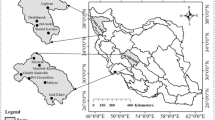Abstract
In this study, Artificial Intelligence techniques such as Artificial Neural Network (ANN), Model Tree (MT) and Genetic Programming (GP) are used to develop daily pan evaporation time-series (TS) prediction and cause-effect (CE) mapping models. Ten years of observed daily meteorological data such as maximum temperature, minimum temperature, relative humidity, sunshine hours, dew point temperature and pan evaporation are used for developing the models. For each technique, several models are developed by changing the number of inputs and other model parameters. The performance of each model is evaluated using standard statistical measures such as Mean Square Error, Mean Absolute Error, Normalized Mean Square Error and correlation coefficient (R). The results showed that daily TS-GP (4) model predicted better with a correlation coefficient of 0.959 than other TS models. Among various CE models, CE-ANN (6-10-1) resulted better than MT and GP models with a correlation coefficient of 0.881. Because of the complex non-linear inter-relationship among various meteorological variables, CE mapping models could not achieve the performance of TS models. From this study, it was found that GP performs better for recognizing single pattern (time series modelling), whereas ANN is better for modelling multiple patterns (cause-effect modelling) in the data.








Similar content being viewed by others
Explore related subjects
Discover the latest articles and news from researchers in related subjects, suggested using machine learning.References
V.P. Singh, C.-Y. Xu, Evaluation and generalization of 13-mass transfer equations for determining free water evaporation. Hydrol. Process. 11(3), 311–323 (1997). doi:10.1002/(SICI)1099-1085(19970315)11:3<311:AID-HYP446>3.0.CO;2-Y
Ö. Kişi, Daily pan evaporation modelling using multi-layer perceptrons and radial basis neural networks. Hydrol. Process. 23(2), 213–223 (2009). doi:10.1002/hyp.7126
R. Arunkumar, V. Jothiprakash, Reservoir evaporation prediction using data driven techniques. J. Hydrol. Eng. 18(1), 40–49 (2013). doi:10.1061/(ASCE)HE.1943-5584.0000597
A. Guven, Ö. Kişi, Daily pan evaporation modeling using linear genetic programming technique. Irrig. Sci. 29(2), 135–145 (2011). doi:10.1007/s00271-010-0225-5
K.P. Sudheer, A.K. Gosain, D. Mohana Rangan, S.M. Saheb, Modelling evaporation using an artificial neural network algorithm. Hydrol. Process. 16(16), 3189–3202 (2002). doi:10.1002/hyp.1096
Ö. Kişi, Modeling monthly evaporation using two different neural computing techniques. Irrig. Sci. 27(5), 417–430 (2009). doi:10.1007/s00271-009-0158-z
A. Rahimikhoob, Estimating daily pan evaporation using artificial neural network in a semi-arid environment. Theor. Appl. Climatol. 98(1–2), 101–105 (2009). doi:10.1007/s00704-008-0096-3
H. Tabari, S. Marofi, A.-A. Sabziparvar, Estimation of daily pan evaporation using artificial neural network and multivariate non-linear regression. Irrig. Sci. 28(5), 399–406 (2010). doi:10.1007/s00271-009-0201-0
M.E. Keskin, Ö. Terzi, Artificial neural network models of daily pan evaporation. J. Hydrol. Eng. 11(1), 65–70 (2006). doi:10.1061/(ASCE)1084-0699(2006)11:1(65)
J. Shiri, Ö. Kişi, Application of artificial intelligence to estimate daily pan evaporation using available and estimated climatic data in the Khozestan Province (South Western Iran). J. Irrig. Drain. Eng. 137(7), 412–425 (2011). doi:10.1061/(ASCE)IR.1943-4774.0000315
S. Kim, H.S. Kim, Neural networks and genetic algorithm approach for nonlinear evaporation and evapotranspiration modeling. J. Hydrol. 351(3–4), 299–317 (2008). doi:10.1016/j.jhydrol.2007.12.014
H. Abghari, H. Ahmadi, S. Besharat, V. Rezaverdinejad, Prediction of daily pan evaporation using wavelet neural networks. Water Resour. Manag. 26(12), 3639–3652 (2012). doi:10.1007/s11269-012-0096-z
V. Jothiprakash, S. Kirty, M.S. Tara, Prediction of meteorological variables using artificial neural networks. Int. J. Hydrol. Sci. Technol. 1(3/4), 192–206 (2011). doi:10.1504/IJHST.2011.043284
K. Raza, V. Jothiprakash, Multi-output ANN model for prediction of seven meteorological parameters in a weather station. J. Inst. Eng. Ser. A 95, 221–229 (2014). doi:10.1007/s40030-014-0092-9
A. Erdil, E. Arcaklioglu, The prediction of meteorological variables using artificial neural network. Neural Comput. Appl. 22(7–8), 1677–1683 (2012). doi:10.1007/s00521-012-1210-0
S.B.K. Tan, E.B. Shuy, L.H.C. Chua, Modelling hourly and daily open-water evaporation rates in areas with an equatorial climate. Hydrol. Process. 21(4), 486–499 (2007). doi:10.1002/hyp.6251
J.R. Quinlan, Learning with continuous classes, in Machine Learning (World Scientific, Singapore, 1992), pp. 343–348
D.P. Solomatine, A. Ostfeld, Data-driven modelling: some past experiences and new approaches. J. Hydroinform. 10(1), 3 (2008). doi:10.2166/hydro.2008.015
D.P. Solomatine, K.N. Dulal, Model trees as an alternative to neural networks in rainfall—runoff modelling. Hydrol. Sci. J. 48(3), 399–411 (2003). doi:10.1623/hysj.48.3.399.45291
V. Jothiprakash, A.S. Kote, Effect of pruning and smoothing while using M5 model tree technique for reservoir inflow prediction. J. Hydrol. Eng. 16(7), 563–574 (2011). doi:10.1061/(ASCE)HE.1943-5584.0000342
M.A. Ghorbani, V.P. Singh, R. Daneshfaraz, M.H. Kashani, modelling pan evaporation using genetic programming. J. Stat. Adv. Theory Appl. 8(1), 15–36 (2012)
V. Jothiprakash, M.G. Devamane, K. Sasireka, Inter-comparison of temperature-based reference crop evapotranspiration methods. J. Inst. Eng. Agric. Eng. Div. 88(DECEMBER), 19–26 (2007)
V. Jothiprakash, M.G. Devamane, K. Sasireka, Inter-comparison of radiation based reference crop evapotranspiration methods. J. Inst. Eng. Agric. Eng. Div. 89(DECEMBER), 22–27 (2008)
R. Tadeusiewicz, Neural Networks: A Comprehensive Foundation, 2nd edn. (Prentice Hall PTR, Upper Saddle River, NJ, 1995). doi:10.1016/0967-0661(95)90080-2
J.P. Bigus, Data Mining With Neural Networks: Solving Business Problems from Application Development to Decision Support (McGraw-Hill Inc, Hightstown, NJ, 1996)
J.A. Freeman, D.M. Skapura, Neural Networks: Algorithms, Applications, and Programming Techniques (Addison Wesley Longman Publishing Co., Inc, Redwood City, CA, 1991)
I.H. Witten, E. Frank, Data Mining: Practical Machine Learning Tools and Techniques with Java Implementations (The Morgan Kaufmann Series in Data Management Systems) (Morgan Kaufmann Publishers Inc., San Francisco, CA, 1999)
J.R. Koza, Genetic Programming—On the Programming of Computers by Means of Natural Selection (MIT Press, Cambridge, 1992)
V. Babovic, M. Keijzer, Genetic programming as a model induction engine. J. Hydroinform. 2(1), 35–60 (2000)
J.A. Foster, Review: Discipulus: A Commercial Genetic Programming System. Genet. Program Evolvable Mach. 2, 201–203 (2001). doi:10.1023/A:1011516717456
S.M. Mousavi, A.H. Alavi, A.H. Gandomi, A. Mollahasani, Nonlinear genetic-based simulation of soil shear strength parameters. J. Earth Syst. Sci. 120(6), 1001–1022 (2011). doi:10.1007/s12040-011-0119-9
Author information
Authors and Affiliations
Corresponding author
Appendix
Appendix


Rights and permissions
About this article
Cite this article
Arunkumar, R., Jothiprakash, V. & Sharma, K. Artificial Intelligence Techniques for Predicting and Mapping Daily Pan Evaporation. J. Inst. Eng. India Ser. A 98, 219–231 (2017). https://doi.org/10.1007/s40030-017-0215-1
Received:
Accepted:
Published:
Issue Date:
DOI: https://doi.org/10.1007/s40030-017-0215-1




